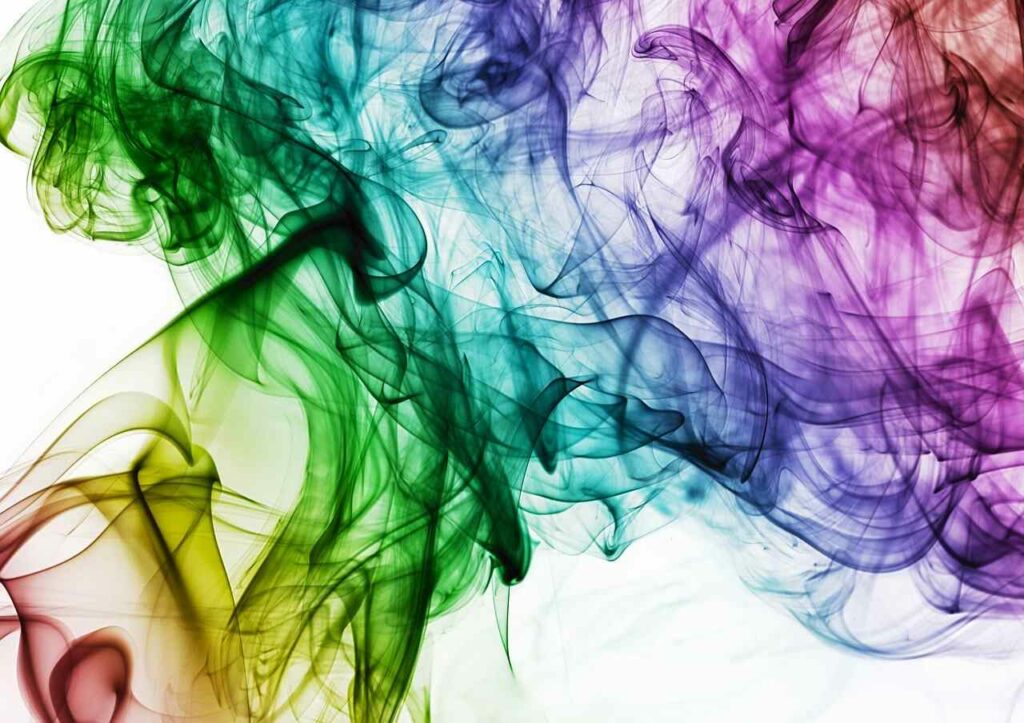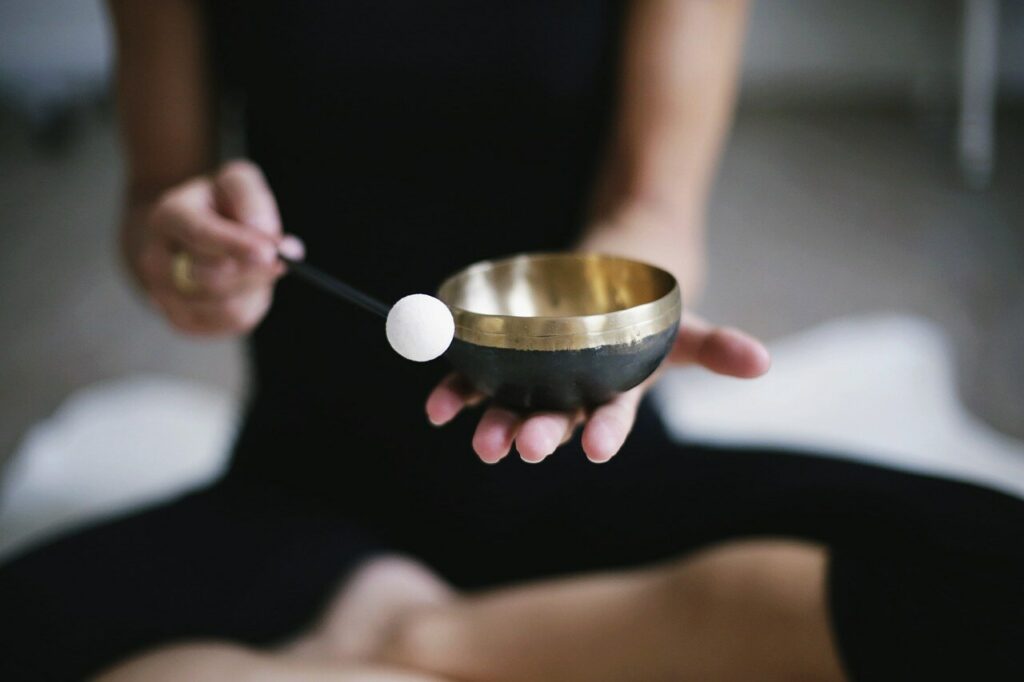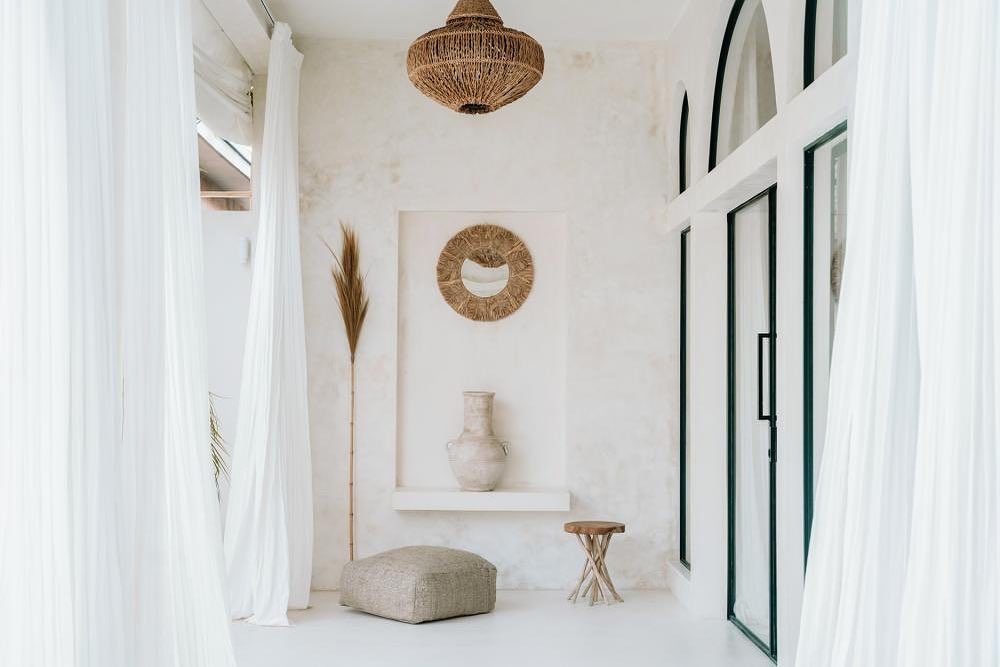Color psychology reveals how different colors do more than beautify our spaces—they shape our mood, emotions, behaviors, and even societal trends through their profound effect on the mind. Dive into the fascinating world of color psychology and learn how to use color schemes to create a happy home that reflects your living style and embraces natural decor.
In this article, we’ll explore the impact of colors on society, their psychological effects, modern research findings, how they enhance performance in home workspaces, and practical tips so you can make more informed decisions in your home decor to create your soulful nest.
Table of Contents
What is Color Psychology?
The fascinating world of color psychology explores how colors significantly impact human emotions, perceptions, and behaviors. From the calming blue of a bedroom to the vibrant yellow of a kitchen, thoughtful color schemes play a pivotal role in shaping the ambiance of our homes and our emotional well-being.
The Impact of Colors on Society
Colors shape societal norms, cultural practices, and collective behaviors in profound ways, as the way we perceive colors can even influence social dynamics:
- Cultural Symbolism: Colors carry diverse meanings across cultures. White represents purity in Western weddings but mourning in many Asian traditions, influencing rituals and social interactions, with each color alone evoking unique emotional responses based on cultural personal experience.
- Branding and Marketing: Companies use warm colors like red to evoke urgency and excitement (e.g., Coca-Cola) or cool tones like blue to convey trust (e.g., IBM), driving consumer behavior and societal trends through their effect on the mind.
- Urban Design: Cities use the color green in parks to promote relaxation or vibrant murals to foster creativity, reflecting the trend toward natural decor in public spaces that can reduce stress and influence feelings.
- Social Movements: e.g. pink for breast cancer awareness or rainbow hues for inclusivity unify communities and inspire action, showing how people react to colors to create positivity.
- Education and Accessibility: Schools use calming cool tones like blue to enhance focus, while high-contrast hues improve accessibility, supporting societal equity and leveraging colors to simulate productive environments.
By influencing emotions and behaviors, colors shape how societies connect, communicate, and thrive in everyday life.
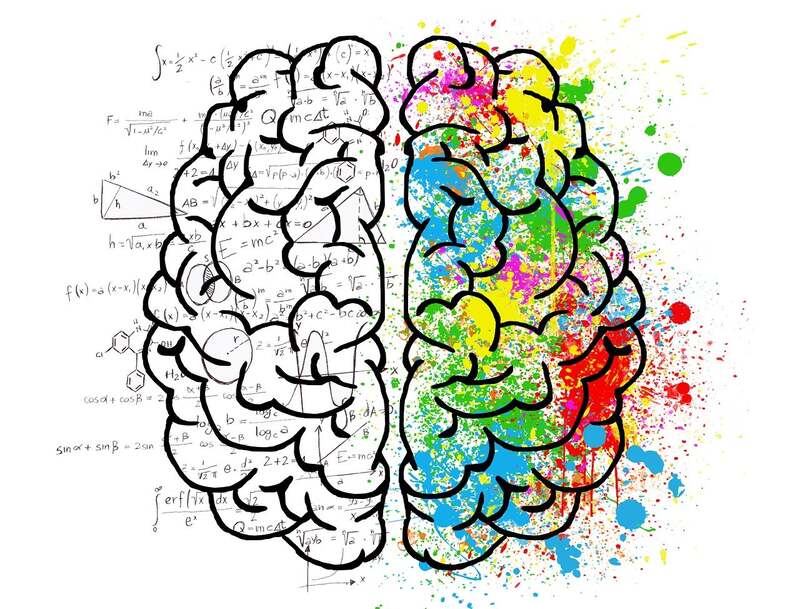
Psychological Effects of Colors on Human Behavior and Emotions
Understanding color psychology reveals how certain colors trigger specific psychological and physiological responses, influencing how we act, react, and feel in our environments. Here’s how the impact of colors influence our beings, with applications for your happy home to shape emotions and model desired states:
- Blue: Lowers heart rate and promotes calmness to calm, encouraging restful behaviors like sleep or meditation. Ideal for bedrooms or bathrooms with natural materials like cotton or bamboo, blue’s cool tones reduce stress and can make spaces feel cold yet serene, based on how individuals sense colors.
- Green: Green fosters balance and focus, prompting productivity or relaxation. Perfect for living rooms or home offices with wooden furniture or plants, it leverages blue and green synergy to effect us positively.
- Yellow: Sparks joy and creativity, encouraging sociability with its attention-grabbing vibrancy and optimism. Use in kitchens or dining areas, but sparingly to avoid overstimulation, as this warm color can evoke lively emotional responses.
- Red: Stimulates energy and appetite, prompting action with its attention-grabbing intensity and sense of urgency. Best for social spaces like dining rooms but can cause agitation if overused, as each color alone shapes emotional responses.
- Neutral Tones (White, Beige, Gray): Promote calm and versatility, encouraging clarity to soothe the mind. Pair with natural decor like stone or jute for a timeless aesthetic that fosters positivity in everyday life.
- Purple: Inspires creativity and introspection, ideal for art studios or reading nooks, leveraging its unique effect on the mind.
- Orange: Boosts enthusiasm and interaction, perfect for communal areas like living rooms with its attention-grabbing warm tones that influence mood and simulate energy.
Choosing the right colors helps you design spaces that align with your desired behaviors, from relaxation to creativity, tailored to your personal experience.
Modern Research on Color Psychology
While color psychology offers valuable insights, modern research highlights both its potential and limitations, showing how people react to colors. Many psychologists view color therapy with skepticism, noting that its effects are often exaggerated and vary across cultures. For example, white symbolizes purity in Western cultures but mourning in many Asian traditions, affecting how we perceive colors and their effect on the mind.
Research also suggests that the mood-altering effects of colors may be temporary. A room with cool tones like blue or pastel tones may initially soothe and reduce stress, but this effect often fades with prolonged exposure. Despite these caveats, studies have uncovered surprising ways colors significantly impact us:
- Medical Perceptions: White-colored pills are associated with greater pain relief, while warm colors like red are perceived as having stronger stimulant properties, influencing patient expectations and outcomes through emotional responses.
- Athletic Performance: Red causes people to react with greater speed and force, potentially enhancing performance in athletic activities with a sense of urgency, according to research findings.
- Sports Dynamics: Players in black uniforms are more likely to receive penalties in competitive sports, possibly due to perceptions of aggression, highlighting how each color alone can shape social dynamics.
- Consumer Behavior in Marketing: Warm colors like red-yellow and orange in marketing campaigns stimulate urgency and excitement, influencing consumer decision and driving purchasing behavior. Analytical studies, like marketing research, show these hues evoke strong emotional responses, shaping how shoppers perceive brands and products.
While these findings highlight the impact of colors, additional research is needed to fully understand their long-term effects and cultural nuances. In your happy home, consider these insights when choosing the right colors, but personalize them to your living style, cultural context, and personal experience to simulate desired moods.
Goethe on the Psychology of Color and Emotion
Johann Wolfgang von Goethe, in his 1810 work Theory of Colours, famously said, “Colours are the deeds and sufferings of light.” This poetic insight reflects his view that colors are dynamic expressions of light, evoking emotions and shaping our experiences. Goethe believed warm colors like yellows could inspire joy and cool tones like blue and green could soothe, ideas that align with modern color psychology. By pairing these hues with natural materials like wood or linen, you can create a happy home that embodies his vision of colors as emotional forces that influence mood and effect mood in everyday life.
Colors influence Emotions: A Visual Guide
The chart below illustrates how colors impact influences emotion and affect mood , offering a guide for designing your happy home. Use it to choose the right hues that enhance your living style and recreate positive energy in your nest. This chart highlights how different hues evoke emotions, guiding your color choices for a vibrant, emotionally balanced home that fosters optimism.
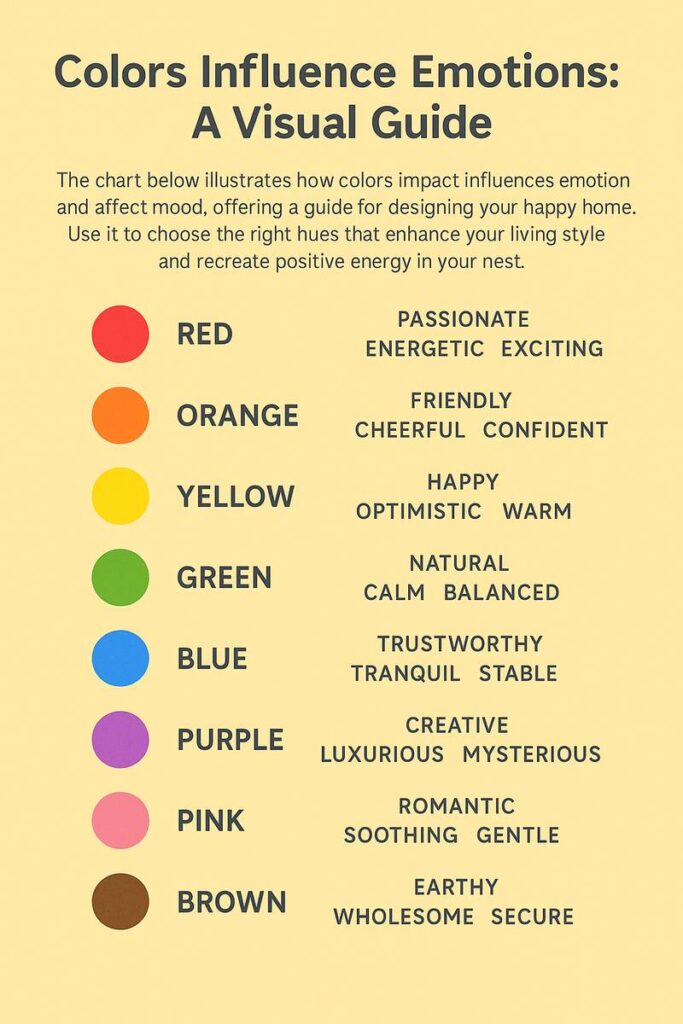
Creating a Happy Home with Color Psychology
A happy home reflects your personality while fostering positivity and emotional responses. Here’s how to use color psychology to simulate desired moods:
- Choose Mood-Driven Colors: Select different hues like warm colors (e.g., earthy greens and browns) paired with natural materials like wood or jute to create a grounding, cozy space that can reduce stress.
- Balance Bold and Neutral Tones: Combine attention-grabbing warm tones like mustard yellow with neutrals like beige to add warmth without overwhelming the senses, enhancing optimism.
- Maximize Natural Light: Colors appear differently under natural light, amplifying their effect on the mind. Use sheer curtains or skylights to enhance vibrancy and complement natural decor in everyday life.
- Incorporate Biophilic Design: Add plants to amplify the color green’s calming effects, strengthening the connection to nature in your living style to soothe and influence mood.
- Use Accents Strategically: Introduce pops of warm colors or cool tones through rugs, cushions, or artwork to add personality without permanent changes, tailored to personal experience.
By choosing the right colors, you can create a space that uplifts and inspires, leveraging how people react to colors.
Mixing Natural Decor with Colors
Natural decor emphasizes organic materials which pair beautifully with a strategic color scheme. Here’s how to integrate them to influence mood:
- Earthy Tones: Warm colors like terracotta, olive green, and warm browns complement natural materials, creating a cohesive, grounding aesthetic that promotes positivity.
- Texture and Color Synergy: Pair rough textures like burlap or reclaimed wood with soft cool tones like sage green or cream for visual and tactile comfort that can soothe and reduce stress.
- Nature-Inspired Accents: Use greenery or stone accents to enhance the color green’s calming effects, fostering a biophilic connection to nature that simulates calm in everyday life.
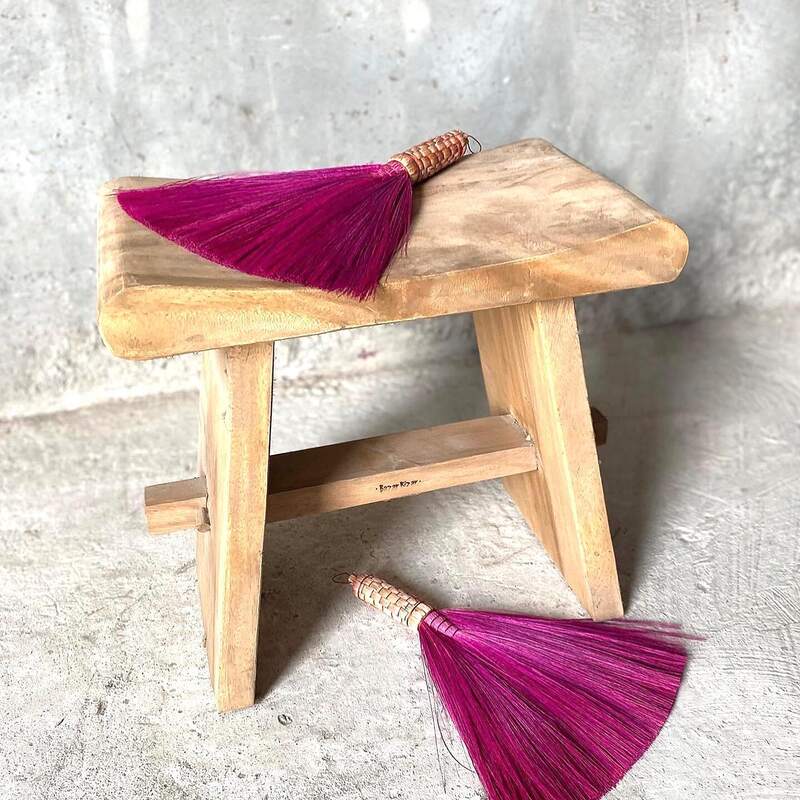
Combining different colors with natural decor creates a happy home that feels both stylish and nurturing, amplifying emotional responses.
Can Color Influence Performance? Optimizing Your Home Workspace
Color was also shown to boost creativity when working from home by enhancing focus, performance, and energy. Through color psychology, you can design a home workspace that supports your living style and creates a happy home.
Here’s how different colors can affect performance:
- Blue for Focus: Blue promotes mental clarity and calmness to soothe, ideal for tasks like writing or data analysis. Paint an accent wall blue or add blue decor, paired with natural materials like a wooden desk or cotton rug, though it may feel cold if overused.
- Green for Productivity: Green represents balance and reduces mental fatigue, perfect for long work hours. Incorporate sage green walls or plants to enhance natural decor and productivity, leveraging blue and green to reduce stress.
- Yellow for Creativity: Yellow sparks joy and innovative thinking, great for brainstorming with its attention-grabbing optimism. Use as accents (e.g., a mustard yellow chair) with neutral tones and natural materials like jute.
- Neutral Tones for Clarity: Whites or beiges create a distraction-free environment, supporting consistent performance. Pair with wooden furniture or linen curtains for a timeless aesthetic that fosters positivity.
- Red or Orange for Energy: These warm colors boost motivation for high-energy tasks like meetings with a sense of urgency. Use sparingly (e.g., an orange lamp) to avoid overstimulation, combined with stone or cotton accents to simulate energy.
Tips for Your Workspace:
- Match Colors to Tasks: Use blue and green for focus, yellow for creativity, and red for energy, based on how you react to colors.
- Incorporate Natural Decor: Pair earthy warm tones with wood or plants for a calming, organic vibe that reduces stress.
- Balance Hues: Combine attention-grabbing accents with neutral bases to maintain focus and effect mood positively.
- Test Lighting: Use natural light to enhance how you perceive colors, complementing natural decor in everyday life.
By choosing the right color schemes, you can create a productive, inspiring workspace that enhances performance through emotional responses.
Practical Tips for Applying Color Psychology in Your Home
Ready to transform your home?
- Here are actionable steps to harness color psychology for your living style to influence mood and simulate desired states:
- Test Colors First: Use paint swatches or temporary decor to see how different hues look under natural and artificial light, ensuring they align with your personal experience.
- Layer Complementary Hues: Combine colors like blue and green or warm tones like orange and brown for harmony and balance to effect mood.
- Align with Room Function: Choose the right colors like calming cool tones for bedrooms, attention-grabbing oranges for social spaces, and the color green for workspaces to reduce stress.
- Personalize Your Palette: Select color schemes that resonate with your personality to create a space that feels uniquely yours, fostering optimism in everyday life.
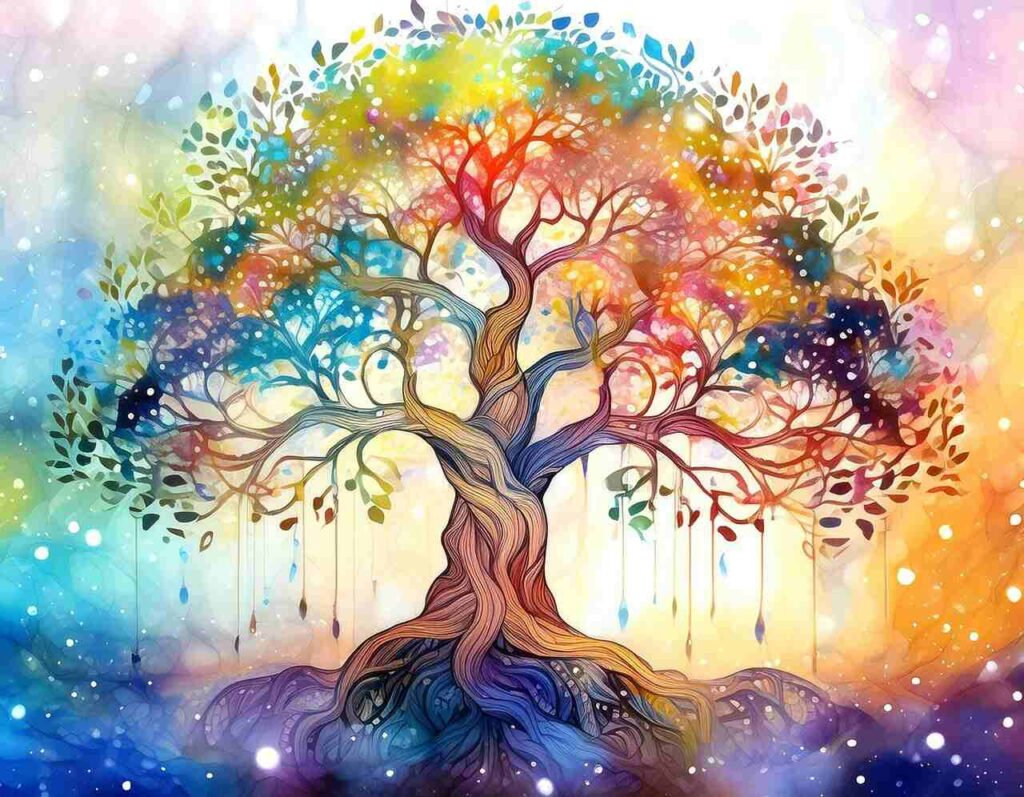
FAQs
How can I choose colors for my living space that promote positivity and well-being?
Choices based on their psychological and spiritual impact of colors can greatly enhance your space. Warm colors like orange and yellow are great for social spaces as they boost energy and positivity. For relaxation, try cool colors like blue and green, which have calming effects on the mind and body. Consider incorporating your personal connection to colors and the spiritual significance each color holds for you.
What are some colors with powerful spiritual meanings, and how do I use them in my home?
Colors like purple, often linked to spirituality and intuition, work beautifully in meditation spaces or quiet areas. Green is associated with renewal and harmony, making it ideal for spaces where you want to foster balance and growth, like a home office. Red, tied to passion and vitality, can be used sparingly to add energy to any room. These colors not only enhance a room’s mood but can also deepen your connection to the space spiritually.
How does color perception differ across cultures, and why is it important in home design?
Color meanings vary widely across cultures. For example, white symbolizes purity in many Western cultures, but in some Eastern cultures, it represents mourning. Recognizing these differences can help you choose colors that resonate personally and culturally, creating a more harmonious and inclusive home environment.
Can the impact of colors help improve focus and productivity in a home office?
Yes! Colors like blue and green are known to boost focus and concentration. Blue, in particular, promotes calm and clear thinking, making it an excellent choice for workspaces. Yellow can also be used as an accent color to spark creativity and uplift your mood, but avoid overly bright shades, which can be distracting.
How does personal experience impact our emotional response to colors in the home?
Our experiences heavily influence our reactions to colors. For instance, if a certain shade of yellow reminds you of a happy memory, you may feel uplifted in a room with that color. Alternatively, colors linked to difficult experiences may feel less comfortable. Recognizing these personal connections allows you to create spaces that are emotionally supportive and reflective of your journey.
Can colors really improve mood, or is it just a placebo effect?
Research supports that colors genuinely affect mood and behavior. For example, blue can lower heart rates and reduce stress, while yellow can stimulate joy and optimism. Incorporating mindful color choices in your home can enhance your environment and make it more aligned with your emotional needs and spiritual intentions.
How can I balance different colors in a multi-purpose room without overwhelming the space?
To balance colors in a multi-use room, start with a neutral base color that creates harmony, like soft grays or whites. Add pops of color with accessories or small decor items based on the room’s activities—energizing shades for work areas and calming tones for relaxation zones. This approach allows you to keep the space versatile without making it feel cluttered or chaotic.
What have we learned about Color Psychology?
Color psychology is a transformative tool for creating a high-end, happy home that reflects your living style and nurtures your emotional responses. From shaping societal trends to influencing individual behaviors, the impact of colors is profound.
Modern research highlights their potential, from enhancing athletic performance to influencing medical perceptions, though effects may vary by culture and duration. By choosing the right color schemes, pairing hues like calming blue and green, renewing color green, or joyful yellows with natural materials, you can craft a space that simulates positivity, promotes cleanliness, and fosters a strong association with nature.
For example, warm colors like red can stimulate appetite in dining areas, enhancing social experiences. Color was also shown to significantly impact performance in home workspaces, with cool tones like blue helping to soothe and reduce stress.
Start and have fun by experimenting with different hues today to transform your home into a sanctuary of well-being that influences mood and enhances everyday life.


